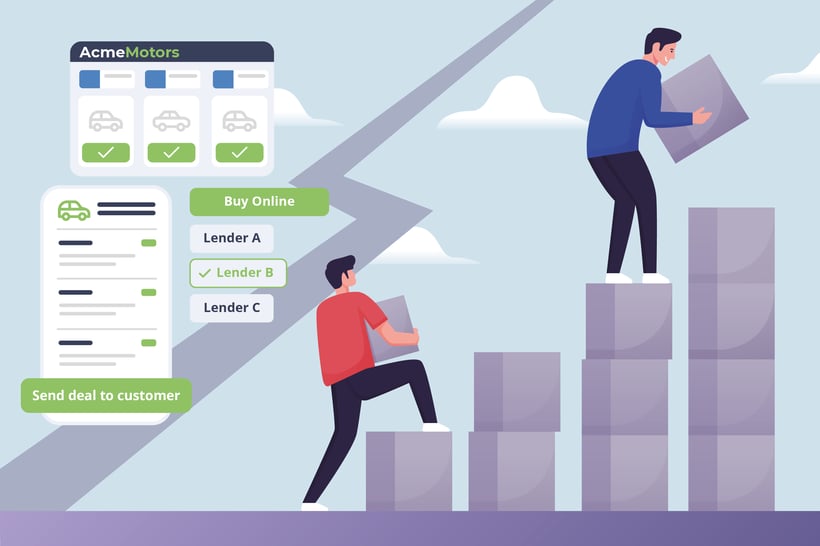Digital tools indeed influence consumer behaviour across most commercial industries, however, the characteristics can vary by sector.
There is no single path towards digital optimisation, the tools available and the speed of progression depend largely on the type of business and scale of operations, as well as consumer expectations for the products or service they’re engaging with.
For many sectors, the pandemic accelerated digital innovation in retail. Consumer expectations have leapt forward in the last five years, and most now expect an experience akin to Amazon or John Lewis.
In this blog post, we’ll be covering what the new digital divide means, and especially what it means for modern vehicle retail, and provide insight on how your business can start to bridge the gap.
What is the new digital divide?
When the pandemic hit, many dealerships were presented with a choice. The choice between adopting digital transformation that could ensure their business could continue to operate, and, closing for an undetermined amount of time.
The resulting digital divide that’s currently impacting the automotive retailer is a technological one, between simple and complex technologies that both facilitate the online customer journey.
Simple technologies that offered relatively rudimentary online customer journeys, and ones that offered a more advanced online experience, which suited the businesses online and offline needs.
Why addressing the digital divide is important
As lockdowns became the new normal, purchasing activity from business and the consumer went digital.
In the UK, online retail sales grew 74% year-on-year and omnichannel retailers were the biggest winners, seeing a 99.8% year-on-year growth in sales across their online channels compared to their online-only equivalents.
Over 59% of global consumers are interested in buying vehicles online and prospective buyers are less inclined to interact with sellers at a physical dealership. A preference that is falling across all regions and age groups, especially amongst the 55 – 70 groups, who now see online retail as a viable alternative to visiting dealers.
Bridging the gap
Our CEO James Tew explained COVID-19 had forced dealers to accelerate their digitalisation plans and that the sector had made huge progress, with a much greater number of solutions in place — but the capabilities of the technology adopted varied widely.
James explains: “It’s no exaggeration to say that dealers have moved on perhaps five years in 18 months because of the pandemic, thanks to the need to adopt technology that could handle the effects of lockdowns and remote selling.
“However, those dealers that have adopted e-commerce products will have seen varied results and this is where we have seen a new digital divide becoming apparent.
“Some technology is well-established and relatively good at simply generating applications and online reservations. These systems do not really achieve much beyond these limitations, but that’s not a criticism — for some dealers, right now, that is as much as they want to achieve online.
“On the other hand, some have looked to reap the rewards of digitisation and now have comprehensive online customer journeys in place that can replicate almost every process step that might take place in a face-to-face showroom sale.”
James said that these more sophisticated and effective solutions required a change in mindset and required dealers to examine their business models in detail.
“Key questions need to be asked including 'What processes need to change or adapting to optimise a digital purchasing channel?’, and ‘How do I handle more complex situations such as adjusting vehicle and part exchange price, upselling warranties, managing finance declines, negative equity and more?’
“All of these factors are features of most car purchases, but older solutions will not be able to resolve them, effectively bringing the online customer journey to a halt.
“Better technology makes handling these points easy and highlights where the digital divide lies. It’s the difference between what is sometimes described as a ‘happy path’ sales journey, with no complications, and those complex processes that make up most real-world car purchases.
“What is becoming clear is that those dealers who we have seen adopt more advanced systems are continuing with a relatively high level of online transactions in the post-Covid market, while those using older technology have seen more of a falling off”.
Next Steps?
The next step for many dealerships is now getting the right technology in the business.
Tools that help maintain profitability in any trading environment.
iVendi’s tools enable dealerships to provide a connected retailing experience, where their online and showroom customer journeys work together. Providing essential showroom services to online customers, whilst also bringing the efficiencies of online into the showroom.
Some of our customers taking advantage of the iVendi Connected Retailing range had this to say:
Jamie Caple, of Car Quay in Derby, and user of the iVendi TRANSACT platform commented: “I think customers are becoming more open to buying online. People want to get everything done, and often only want one visit to the showroom. We use technology like yours to make sure that the deal is pretty much wrapped up, so when they come into the showroom, they can drive the car away.”
Adrian Cairns, Finance Controller at Kendrick Cars, and also a user of iVendi TRANSACT said the following about online motor retailing: “It is inevitable that the customer is moving increasingly online. More and more are getting comfortable about buying entirely digitally. There is still a percentage who want to try the car and to have a good look at it before committing, but even those buyers will have done their research online. They can access any information they want about the car, the finance, the part-exchange and arrive at the showroom far more clued-up than in the past."
Find out more about how iVendi sees the future of vehicle retailing by downloading our latest white paper, Connected Retailing: Addressing the Challenges of Digital transformation.
Or, see what more of our customers had to say by reading our latest testimonial case studies.

